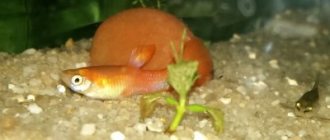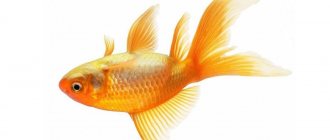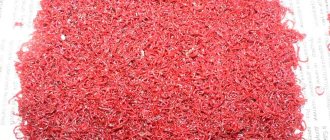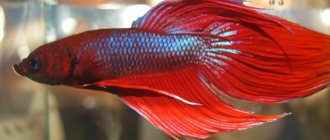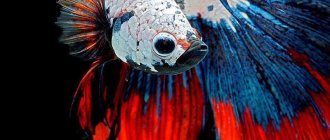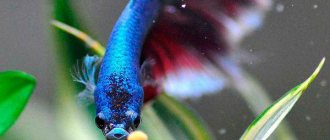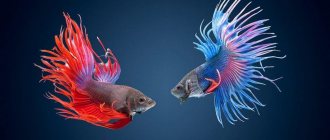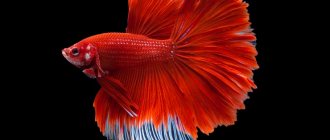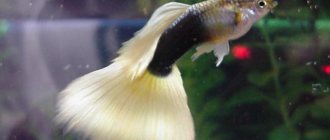Reasons for refusing dry food
Bettas, like many aquarium fish, are not very picky eaters. They often enjoy eating both live food and dry food. However, there are many factors that cause bettas to ignore food or spit out chewed food. This may be a natural reaction, for example, to a change in external living conditions, or it may signal that the “rooster” requires special attention. Let's look at the main situations in which a betta fish does not eat food.
Adaptation period
After a betta moves from its usual aquarium in a pet store, where the lighting level, water temperature and feeding time were the same, to a place where the external conditions have changed, it begins to adapt.
The betta may not eat for 7 days after moving from the pet store, and this is normal.
The mechanism of adaptation to a new environment, developed by nature during the development of a particular species, can manifest itself as a refusal of food. Therefore, if your betta fish does not eat well or does not eat dry food at all after moving from the store, perhaps it needs to be given time to get used to its new “home.” It is generally accepted that the adaptation period lasts for 7 days, during which the pet can completely refuse food, but continues to feel well.
Improper care
Most likely, the fish will not eat well if the environment does not match the rooster's usual habitat. Since this is a tropical species of waterfowl, they require special conditions:
temperature 26-28 degrees;
the volume of the aquarium is at least 5 liters;
cleanliness: food that these fish have not eaten within 2-5 minutes is removed.
There is an opinion that since these creatures can live in ponds with muddy water, feeling great in rice fields, then keeping them in an aquarium does not require special attention. This is absolutely not true. If the pet does not feel comfortable, then it may not only stop eating, there is a high risk that the fish will die. For this reason, refusal to eat should be a signal that something is wrong with the betta.
The cockerel feels good in an aquarium with a volume of 7-10 liters. In cramped small aquariums (less than 5 liters) he gets sad and stops eating.
The volume of the aquarium, which will allow the pet to feel comfortable, should be at least 7-10 liters. This is one of the explanations why the cockerel in a three-liter jar does not eat food. The individual must swim, move, and have relative space. If the aquarium contains a cockerel and a chicken, then its volume should not be less than 20-30 liters - this is a prerequisite.
It should be remembered that it is not for nothing that the fighting species has such a name. The representative is steadfastly ready to defend its territory, fighting with other inhabitants of the aquarium and even with its reflection in the mirror. You should not plant fish of the same sex (male) in the same container, as they will definitely fight, causing injury to each other. Bites and injuries often cause infection in the pet's body or the development of inflammation of internal organs. As a result, the males become indifferent to food, the fish behave sluggishly and move little.
The optimal water temperature for a betta is 26-28 degrees - reducing it can lead to refusal of any food.
What makes care easier is that these fish are labyrinthine fish - they get air not only from water, but also swallow it with their mouths. Therefore, you can do without filters and aerations, but it is unacceptable to lower the water temperature below 24-26 degrees. The optimal temperature is 26-28 degrees - reducing it can lead to refusal of any food.
Water hardness should be in the range from 4 to 15 units, and the ph level should be from 6 to 7.5.
At the same time, it is important to monitor such indicators of water as hardness - it should be in the range from 4 to 15 units, and ph level - its values can vary from 6 to 7.5. The lights in the aquarium should be turned off for a period of 6 to 8 hours a day - during this time the fish should be at rest.
Food preferences
Typically, cockerels, regardless of gender, eat dry food, live food, and frozen food well. But it is important to understand that these inhabitants of the aquarium over time get used to a specific image and diet.
If you don’t want your betta fish to stop eating in your home aquarium, find out what he was fed at the pet store and stock up on the same food.
In pet stores, pets are fed the same type, they do not monitor their diet and do not try to teach the fish to eat a variety of foods. Over time, pets get used to, for example, a particular brand of cereal, after which any other food may raise doubts. Of course, the best food for betta fish is natural products (bloodworms, earthworms, brine shrimp, daphnia). You can prepare them yourself or buy them fresh or frozen at pet stores. It is recommended to give bloodworms, artemia and daphnia after freezing, and earthworms - live. If your betta gets bored in the aquarium and stops eating dry food, treat him with live food. Betta fish eat live food much more readily.
If you feed your roosters pellets, make sure they are sized to fit into the fish's small mouth. Unlike live food, pellets are difficult or impossible to break down, and feeding large pellets will leave your betta hungry. But if your pet's appetite has returned, do not overeat. Do not feed them food more than 5% of their weight and remove everything that they do not have time to eat in 2-5 minutes.
Diseases
Another reason why your betta fish spits out food is illness. Most often, aquarium residents suffer from fin rot , caused by various infections. As the disease develops, the fish's fins are completely destroyed and it dies. Among the main symptoms of fin rot are:
the appearance of white ulcers on the scales;
eyes become cloudy;
the fish often hangs in one place;
refuses food for a long time.
To combat the disease, broad-spectrum antibacterial and antifungal drugs are used. The action of these drugs allows you to very quickly suppress a bacterial infection. Afterwards, you can begin symptomatic treatment of the disease. The main therapeutic products used for fin rot are:
Another common disease that occurs in aquarium bettas is ichthyophthyriasis or semolina . The syndrome is characterized by the appearance of white nodules on the body of the fish, which first affect the head, then all the scales. The disease can be compared to the flu that affects people, since it is becoming more and more difficult to cure every year.
Signs of ichthyophthyriosis: the betta fish spits out food, moves slowly and rarely, swims closer to the bottom, rubs against the substrate, shudders, swims in jerks. The main reason for the development of the disease is poor sanitary conditions of the aquarium.
“Semolina” is easy to diagnose; it appears as multiple white spots that eventually cover the entire scale of the aquarium inhabitant. At the same time, the betta fish spits out food, moves slowly and rarely, swims closer to the bottom, rubs against the substrate, shudders, and swims jerkily. The main reason for the development of the disease is poor sanitary conditions of the aquarium.
Along with the use of medicinal products, it is necessary to heat the water in the aquarium to the maximum allowable for this species. If the males are sick, then the temperature in their aquarium should be 30 degrees, but no more.
Therapy for ichthyophthyriosis is based on the use of the following medications:
Along with the use of medicinal products, it is necessary to heat the water in the aquarium to the maximum allowable for this species. If the cockerels are sick, then the temperature in their aquarium should be 30 degrees, but no more, since it will be difficult for its inhabitants to cope with the disease. The water needs to be heated until the spots on the scales disappear completely and for another 3-5 days after that for preventive purposes.
In order not to encounter the problem of food refusal, it is necessary to carefully monitor the condition of the water in the aquarium, constantly changing it. It is necessary to wash the walls of the tank, plant algae and give the fish a variety of food. Cockerels love live food most of all, and bloodworms are considered the biggest delicacy for them.
In general, the feeding principles for these fish are not too different from feeding any other omnivorous aquarium fish. And when illness, cramped conditions or cold stop bothering your pet, he will delight you with his good color and beautiful movements.
What to do if the fish has eaten too much?
I overfed my fish more than once and developed a number of rules for myself, which I will gladly share:
- Change water at short intervals. For example, I change 20 percent, then after 3 hours another 10 percent. And the next day another 15 percent.
- Along with the change, I collect the remaining feed.
- Increased aeration.
- Fasting day.
We will also consider the right paths for popular fish.
What to do if you overfed your cockerel?
As a rule, males live in small aquariums, so when overfeeding, the first thing to do is collect the remaining food.
The second step is to change the water. Ideally, the entire volume, if it is possible to take water from another aquarium. If this is not possible, make changes every 3-4 hours by 20-30 percent until you change the entire volume. If the aquarium is very small (up to 3 liters), then it is better to change 80% of the water and fill it with settled water. You can add aquarium chemicals for water treatment. In general, the volume of replacement depends on how much the fish were overfed. But the above values can be taken as average data.
The third step is a fasting day. After the change, do not feed the betta for 24 hours.
What to do if you overfed your goldfish?
The steps for overfeeding goldfish are the same as for bettas. The only difference is that for goldfish you need to increase the air supply, since when overfed, the fish begin to consume more oxygen to speed up their metabolism.
One of the signs of overfeeding fish is the appearance of a specific fishy smell in the aquarium. Normally, if all maintenance rules are followed, the aquarium has virtually no odor. The first visible signs of overfeeding are the following: - the water quickly becomes cloudy. — algae actively grows on the surface of the water and a film forms. - food residues settle to the bottom of the aquarium. — food residues accumulate on the filters of the cleaning system. — the surface of the leaves of aquarium plants is unusually slippery. It may be hard to believe, but overfeeding is often cited as the main reason for the death of aquarium fish. Overfeeding changes the quality of water in the aquarium, upsetting the balance in its chemical composition, and leading to the “explosive” proliferation of bacteria and microorganisms. Pathogenic organisms do their “dirty deed” - they destroy the inhabitants of your artificial aquatic system. To avoid overfeeding, and as a consequence of disastrous results - the death of the fish, food must be given so much that it is eaten within a few minutes. The required portion can be determined by observing the behavior of the fish when feeding them. If the fish pounce on the food, preventing small crumbs from sinking into the water column, they are hungry. As soon as you begin to observe that the fish begin to play with crumbs of food - sucking up and spitting out, and at the same time showing indifference to the crumbs that sink to the bottom, then at this stage feeding must be stopped.
The cockerel fish lies at the bottom of the aquarium: why does this happen?
The problem when the cockerel lies on the bottom is faced by many beginners, whose choice fell on these unpretentious pets. This usually occurs due to improper care or illness, but can also be natural behavior. To understand whether you need to worry about your pet, you need to understand the factors that affect the well-being of the fish.
Why does the fish stop swimming and lie to the bottom?
There are many reasons why a fish may remain on the bottom for a long time. Do not begin to take action until you clearly understand the situation. Here are a few reasons why your betta may stop behaving normally:
- stress;
- various diseases;
- natural behavior.
For newly purchased fish, stress inevitably arises, because it is not yet accustomed to new conditions. Cockerels are sensitive to all factors; even changing water hardness can affect their behavior. Temperature is also extremely important: if it is below 19 degrees, the fish will remain at the bottom in a comatose state.
Main diseases of betta fish and how to recognize them
The most common disease of this type of fish is fin rot. The main symptom is the appearance of suspicious light spots on the fins. If the disease is not noticed in time, the pet may lose its fins and tail, which is why it will not be able to swim and will sit at the bottom.
Other, less common diseases: dropsy, gill fluke, ichthyophthyriosis. Dropsy can be recognized by the following symptoms: the fish enlarges due to bloating of the abdomen, the scales take on an unnatural, disheveled appearance.
The gill fluke is the main reason why fish lie on their sides and breathe heavily. It can be cured with the help of special antiparasitic agents.
Ichthyophthiriasis is characterized by the appearance of spots on the body and the lack of activity of the pet. In a specialized store you can purchase various remedies: Aquarium Pharmaceuticals, Omnisan and others.
During treatment, the cockerel must be separated from other inhabitants of the aquarium to avoid infection; the fish should be in a container without plants or soil.
Dr.Vladson Oct 17, 2005
In order for the platy to die of hunger, you need to be very patient. She needs at least 2 months for this. In general, something is not entirely clear - there are no symptoms, but the fish feel bad. This doesn’t happen, look more carefully, you might notice something, even little things that seem insignificant in your opinion. For now, tell me what’s wrong with your water, what do the tests show?
If he’s already sitting in Antibak, then let him sit out. Although, in general, in such cases the principle applies - if we don’t know what to treat, then we treat with the strongest one. So you can simply, without further ado, bathe it in baths with Bicillin-5 and look at the result.
When being at the bottom is normal
Sometimes strange behavior is a manifestation of the fish’s natural instincts. Therefore, do not rush to worry if the cockerel lies on the bottom - perhaps this is his natural behavior. These fish live in ponds with stagnant water, so sometimes they are more comfortable at the bottom of the aquarium, where they will not be carried away by the current.
Although there is no water flow in the tank, the fish obeys its instincts. Bettas also like to lean on resting objects and rest. Or they may just doze off. At the bottom, the pet gets acquainted with the new environment and adapts to the new home. In addition, here he is not disturbed by other inhabitants of the aquarium. If you just stocked your betta, he will stay on the bottom for a while. Wait 2-3 days - the fish will get used to its new home and begin to behave as usual.
How to properly set up a new aquarium
Often, beginning aquarists think that it is enough to fill the aquarium with water, turn on the equipment, and the fish’s home is ready. This is irresponsible behavior and can kill any fish, including bettas. It will take time to arrange a habitat for pets: a biosphere must form.
Do not allow chemicals to get into the water under any circumstances. You should also check its composition with special testers. It is recommended to fill in fresh liquid in a volume not exceeding 20% of the total. Check and maintain a comfortable temperature - about 26 degrees. Do not expose inhabitants to sudden changes in environment. Any deviations will lead to illness.
Fin rot
The cause is the bacterium Pseudomonas, which got into the water along with food or new inhabitants. Usually it clings to young or weakened individuals, but if detected untimely, it can destroy the entire population of the aquarium.
The symptoms are:
- Lethargy.
- Sudden change in color.
- Ulcers or bluish plaque on the body.
- Cloudiness of the cornea.
- Blowing bubbles;
- Ugly, drooping, stuck together fins.
Have you noticed one or more signs of fin rot? Begin immediate treatment, and until complete recovery, quarantine the sick fish, otherwise it will infect other pets.
Most often, specialists treat betta fish with streptocide or another antibacterial agent. Thus, treating betta fish with metronidazole gives a quick effect and improved health.
In addition, you can use special products sold in pet stores.
In addition, treatment can be carried out with the following drugs:
- Bicillin-5 (penicillin substance with bactericidal action).
- Biomycin (general purpose antimicrobial antibiotic).
- Malachite green. Treatment is carried out for a maximum of five days (gradually increasing the dosage from 0.5 to 0.7 ml). Only freshly prepared solution is used, the processing process takes five hours.
- Violet K (chlorohydrite). The substance is diluted in proportions of 0.1 grams per liter. Having applied 15 ml of solution, add it to 15 liters of water and pour it into the aquarium.
Antibiotics are given for a couple of months (the norm is 20 grams per 100 liters).
Remember that illnesses in fish occur very quickly: sometimes the clock literally counts. If you doubt the correctness of the diagnosis, you should contact a veterinary clinic or the staff of the Underwater World pet store, who will suggest the ideal medications and help you choose the required dosage.
Incorrect water parameters - the reason for the fish to lie on the bottom
Water directly affects the condition and health of fish. Deviation from the norms of habitat indicators can worsen the condition of the fish to the point that it lies at the bottom of the aquarium. This can last for several weeks and ultimately lead to the death of the pet.
The water should be tested using instruments that will determine the presence of ammonia compounds, nitrites, nitrates and other chemical elements. Water purification must be constantly monitored.
Temperatures outside the normal range lead to changes in fish behavior. Its increase draws the pet to the bottom, that is, to a place where the water is colder. The decrease causes the betta to swim in the upper layers. Also, in cold water, oxygen dissolves less well, and as a result, the fish suffocate. Even at low temperatures, the pet falls into a comatose state due to insufficient energy and slow metabolism and sinks to the bottom.
Oleg69 Oct 18, 2005
Dr. Vladson Sorry, you misunderstood me. You advised him to fast for 5 days. I wrote about the platy - that she didn’t eat for 5 days - it was like a hunger strike for her and it didn’t help. In a total 200L aqua, the pH is probably 8.0 (Serov dibilny test), kH-7, gH-13. That's all what I know. Such problems periodically occur in one fish, although there are several of them. I feed them dry Tetras, frozen brine shrimp, frozen daphnia, washed tubifex for 10 days and then keep them in manganese for 15 minutes once after 10 days. Today seems to be the third day he hasn’t eaten. It just opens up his lips, I noticed today. It seems to me that something is happening in her mouth. Today I became thinner. And in what concentration can you make a bath of Bitsilina 5? Can I take it from Antibak to Bitsilin, and then back? Or is it already possible to replace the Antibak with clean water?
Thank you. Post edited by Oleg69: 18 October 2005 - 07:37
How does the feeding regime of fish affect
The fish should be fed at the designated times according to the schedule. No more than twice a day. When they overeat, their stomach does not have time to digest food; due to the heaviness, they are physically unable to rise from the bottom. This is a very common reason why a betta fish lies on the bottom.
Obesity is a serious disease for betta fish. It entails death, since the fish cannot exist normally. All processes in her body fail. Also, the fish gets tired faster and in a weakened state cannot swim, but only stay below. This disease can only be cured if it is detected at an early stage. If pets become overweight, they should be kept on a strict diet, reducing the amount of food to the bare minimum (unless they are pregnant females).
Oleg69 Oct 16, 2005
That's right - it's a disease. They are not fed, especially swordtails. In the aqua there are barbs, parrots, angelfish, and minors. So swords get the least amount of money. I feed her 2 times a day in small portions. The one who is sick now is young, 2.5-3 months old. At first he hid all the time, I thought the main male was chasing him, but... he chases the others, but they still swim, and this one hides more. When feeding dry, Tetra noticed that he takes it and spits it out. I transplanted it separately into 25 liters, gave it a tubifex - the same thing, while it’s still active, poured Antibak yesterday, today the same thing, gave it frozen brine shrimp - actively attacked it, but spits it out. And if I combine this symptom with thread-like stool, maybe it will help make a diagnosis? Although I'm not sure that I saw exactly such feces from him.
Posts 1 page 10 of 21
Share12011-02-10 18:51:53
- Author: fish23
- Yours on the forum
- Registered: 2011-02-10
- Invitations: 0
- Posts: 10
- Respect: [+0/-0]
- Positive: [+3/-0]
- Time spent on the forum: 3 hours 27 minutes
- Last visit:2011-02-24 22:28:19
Hello! I really need help, there is a problem with the cockerel.1) The volume of the aquarium is 7 liters2) There is a lid, lighting3) Aeration - no, no filter4) Plants: 2 anubias5) The soil is shallow, cm layer 36) I change the water in the aquarium every week 1/37 ) Food - dry flakes, chips, tablets8) water temperature - 26-28 Initially, one cockerel and 2 gourami lived in the aquarium, which he constantly mercilessly chased, then the gourami were placed in a large aqua, 2 chickens were bought for the cockerel, although there is an opinion that in fact, at least 1 of them is a male: at first the rooster chased them, but 2 weeks ago there was a riot and these two “females” fought him as best they could, after which they were put in a jar and live happily there. At first the rooster also lived normally, then a greasy film began to appear on the surface of the water and began to spit out food. Over the course of a week, I changed the water several times, washed the soil and walls, now there is no film, but the cockerel has completely refused food. He doesn't seem to notice him. He hasn’t eaten for 4 days, and he didn’t eat very well the previous days either! What to do?? He has also become inactive and is constantly near the surface of the water.
Edited by fish23 (2011-02-15 00:12:28)
